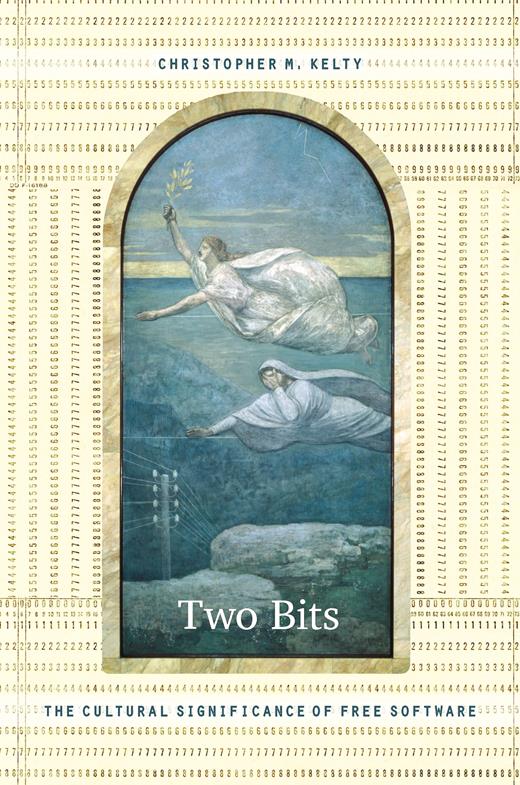Christopher M. Kelty: Two Bits: The Cultural Significance of Free Software (2008–) [EN, ES]
Filed under book | Tags: · commons, copyright, floss, free software, open source, software

“In Two Bits, Christopher M. Kelty investigates the history and cultural significance of Free Software, revealing the people and practices that have transformed not only software, but also music, film, science, and education. Free Software is a set of practices devoted to the collaborative creation of software source code that is made openly and freely available through an unconventional use of copyright law. Kelty shows how these specific practices have reoriented the relations of power around the creation, dissemination, and authorization of all kinds of knowledge after the arrival of the Internet.
Two Bits also makes an important contribution to discussions of public spheres and social imaginaries by demonstrating how Free Software is a “recursive public”-a public organized around the ability to build, modify, and maintain the very infrastructure that gives it life in the first place.Drawing on ethnographic research that took him from an Internet healthcare start-up company in Boston to media labs in Berlin to young entrepreneurs in Bangalore, Kelty describes the technologies and the moral vision that binds together hackers, geeks, lawyers, and other Free Software advocates. In each case, he shows how their practices and way of life include not only the sharing of software source code but also ways of conceptualizing openness, writing copyright licenses, coordinating collaboration, and proselytizing for the movement. By exploring in detail how these practices came together as the Free Software movement from the 1970s to the 1990s, Kelty also shows how it is possible to understand the new movements that are emerging out of Free Software: projects such as Creative Commons, a nonprofit organization that creates copyright licenses, and Connexions, a project to create an online scholarly textbook commons.”
Publisher Duke University Press, 2008
ISBN 0822342642, 9780822342649
xvi+378 pages
Book website
Publisher (EN)
Publisher (ES)
Two Bits: The Cultural Significance of Free Software (English, 2008, 3 MB, HTML (ZIP), updated on 2023-3-14)
Two Bits: la trascendencia cultural del software libre (Spanish, 2019, 8 MB, added on 2023-3-14)
FLOSS Manuals: Pure Data (2006–)
Filed under manual | Tags: · floss, graphical programming, image, image processing, pure data, software, sound, sound processing, video, video processing

Pure Data (or Pd) is a real-time graphical programming environment for audio, video, and graphical processing. Pure Data is commonly used for live music performance, VeeJaying, sound effects, composition, audio analysis, interfacing with sensors, using cameras, controlling robots or even interacting with websites. Because all of these various media are handled as digital data within the program, many fascinating opportunities for cross-synthesis between them exist. Sound can be used to manipulate video, which could then be streamed over the internet to another computer which might analyze that video and use it to control a motor-driven installation.
GNU General Public License version 2
PDF (PDF)
PDF (EPUB)
View online (HTML)
Sam Williams: Free as in Freedom: Richard Stallman’s Crusade for Free Software (2002)
Filed under book | Tags: · copyleft, floss, free software, hacker ethic, open source, software

“Free as in Freedom interweaves biographical snapshots of GNU project founder Richard Stallman with the political, social and economic history of the free software movement. It examines Stallman’s unique personality and how that personality has been at turns a driving force and a drawback in terms of the movement’s overall success. “Free as in Freedom examines one man’s 20-year attempt to codify and communicate the ethics of 1970s era “hacking” culture in such a way that later generations might easily share and build upon the knowledge of their computing forebears. The book documents Stallman’s personal evolution from teenage misfit to prescient adult hacker to political leader and examines how that evolution has shaped the free software movement. Like Alan Greenspan in the financial sector, Richard Stallman has assumed the role of tribal elder within the hacking community, a community that bills itself as anarchic and averse to central leadership or authority. How did this paradox come about? “Free as in Freedom provides an answer. It also looks at how the latest twists and turns in the software marketplace have diminished Stallman’s leadership role in some areas while augmenting it in others. Finally, “Free as in Freedom examines both Stallman and the free software movement from historical viewpoint. Will future generations see Stallman as a genius or crackpot? The answer to that question depends partly on which side of the free software debate the reader currently stands and partly upon the reader’s own outlook for the future. 100 years from now, when terms such as “computer,” “operating system” and perhaps even “software” itself seem hopelessly quaint, will RichardStallman’s particular vision of freedom still resonate, or will it have taken its place alongside other utopian concepts on the ‘ash-heap of history?’
Published by O’Reilly, 2002
ISBN 0596002874, 9780596002879
225 pages
Key terms: GNU Project, Richard Stallman, Unix, Lisp Machine, Linus Torvalds, GNU Emacs, free software movement, AI Lab, operating system, hacker ethic, Free Software Foundation, Sun Microsystems, proprietary software, Steven Levy, GNU Manifesto, source code, Open Publication License, Eric Raymond, Minix, Napster
Comment (1)
